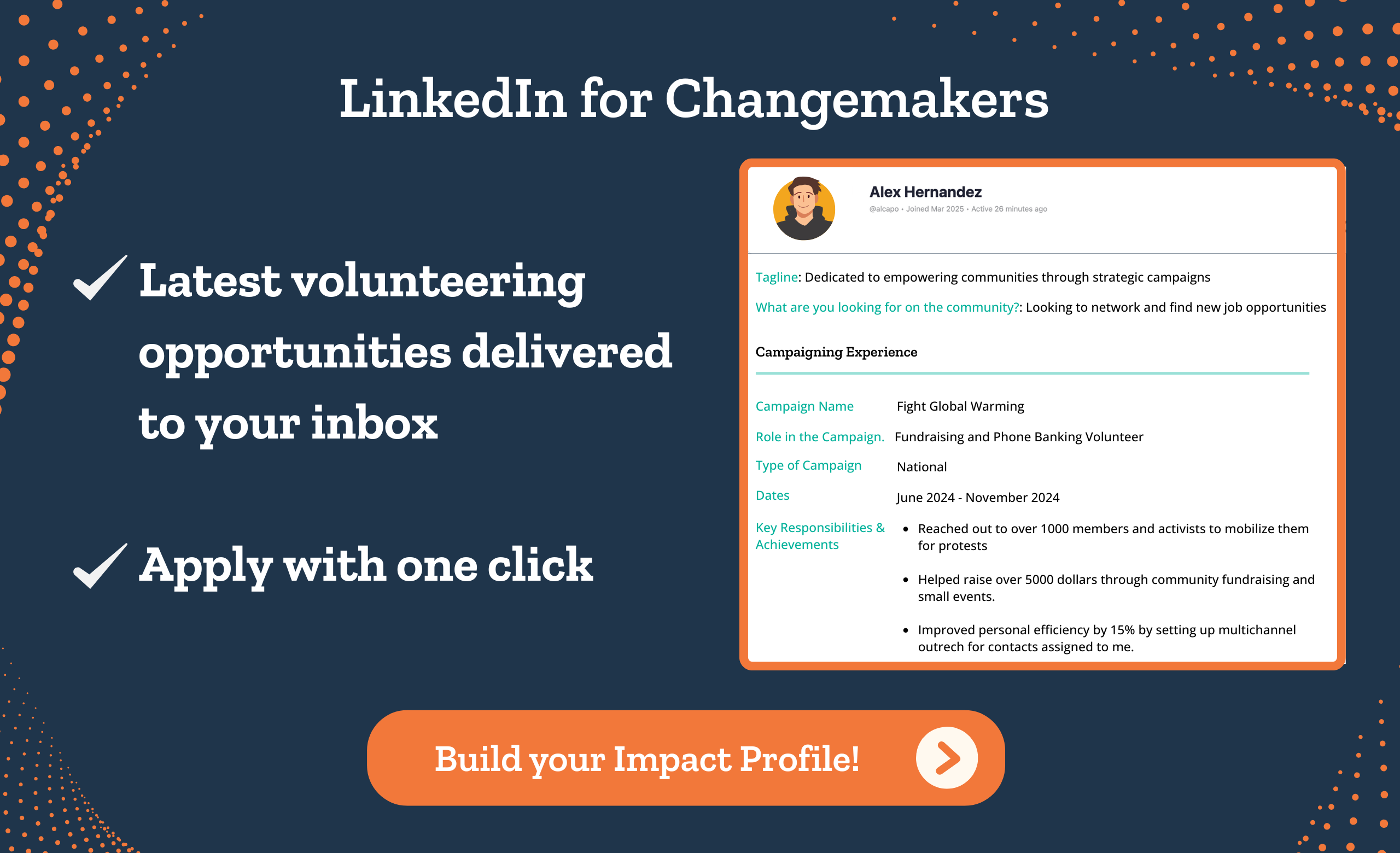Table of Contents
In 2023, charitable giving reached a record-breaking $557.16 billion, highlighting the impact of effective fundraising strategies for small nonprofits. Charitable contributions have increased, and the United States has emerged as the most charitable nation, with 72% of Americans reporting that they have helped a stranger.
That means, if you diversify your efforts the right way, your nonprofit can get more out of the fundraising efforts.
For instance, if you are heavily dependant on grants for fundraising, you can focus on online donations as well to increase your income. If you are a relatively small organization, cultivating donors to make them future major donors is a good idea.
Remember that fundraising is everybody’s responsibility. Right from the top management to the volunteer who makes the first ask.
That means, regardless of which method you choose, every single person in your organization should be onboard. They should all work together in building relationships, fostering trust with prospects, and then winning them over.
With this understanding of fundraising, let us look at the various options at your disposal. Which methods would work for your non profit? How can it fit into your already existing fundraising mix? This post will help you answer those questions.
Fundraising strategies for nonprofits
Fundraising needs a strategic plan that can be easily classified as either online or offline method. This classification is rather simplistic – it is only based on the channel of communication.
However, to get a better clarity on which fundraising ideas and strategies would work for you, it is important to classify fundraising efforts based on the target audience..
That is, who will you approach with your fundraising request?
In this case, there are three options:
Individuals
Individual donations contribute to nearly 3/4th of total charitable donations across the world. That means targeting individuals for donation is not an option for your organization – it is a must. Otherwise, you are losing out on a valuable source of donations.
Unfortunately, approaching individuals for donations is a lot of hard work. It means working on prospecting, identifying a suitable target audience, cultivating them, and finally making the ask.
So your nonprofit should have enough volunteers (trained ones) and the technology to support the entire donor journey.
Companies
Increasingly more companies are looking to give back to society. The percentage contribution of corporate giving in the total charitable giving in the U.S. in 2023 is approximately 6.6%. This means that out of the $557.16 billion total charitable donations, companies contributed $36.55 billion.
Despite the inclination to donate, most companies contribute only 1% of their pre-tax profit to charities.
That is pretty less. Especially in comparison with individuals who donate 2 to 3% of their pre tax income.
What it means for your nonprofit is, (to put it brutally), it could be more trouble than it’s worth. You have to go through a stringent vetting process (that requires a lot of volunteer man-hours) to get selected by a company. Post this, you still have to spend considerable effort in cultivation so that the donation you get is substantial.
So, before you decide to jump into this wagon for fundraising, ask yourself: “Is my organization equipped for this?”. If your nonprofit is in its nascent stage or, does not have the right leadership, then the answer is “Probably not.”
Grants
Since we are talking numbers, let me give you a relatable statistic. Foundation giving increased to $103.55 billion came from grants. Total donations from grants increased by 1.7% when compared to the previous year.
That is a very promising number. However, grants don’t get handed out willy-nilly. Each grant is earmarked for a specific cause.
If your nonprofit’s cause is not aligned with the mission of the grant, then that money is unavailable to you.
For instance, the Bill and Melinda Gates Foundation does not fund purely religious causes. So, if you are a church, you are not eligible for their grant (even if you ask nicely).
To give you perspective, here is a snapshot of Grant Priorities listed by Giving USA.
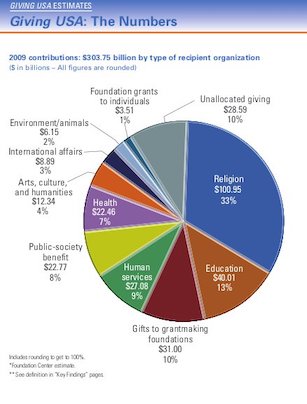
Before you choose to focus on grants as a fundraising effort for your cause and explre other fundraising ideas and determine your eligibility criteria. If you are indeed eligible, keep in mind that grant application is a tedious process that has to be taken very seriously.
If you do not have the manpower or the know-how to do it currently, the best way for you would be to defer it to a later stage.
Based on this information, if you decide to go with just targeting individuals, that is perfectly fine. Not only do you have a multitude of nonprofit fundraising strategies for increasing individual donations, but you can always scale your efforts whenever you deem yourself ready.
Fundraising from individuals
To get exceedingly good at individual donations, you have to understand this fundamental question: “Why do people give?”
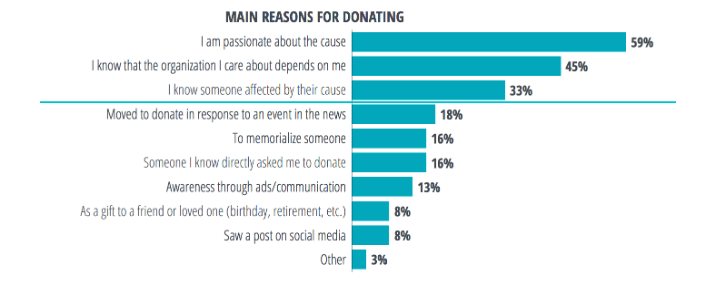
Traditionally, individuals donate only because of tax exemptions. However, the global trend currently is a lot more positive.
People donate because of genuine humanitarian concern. They donate to make a difference, to help each other. They donate because they care.
That does not mean that a prospect will donate at the first touchpoint (maybe if you are very lucky). You still have to make the ask right, so that you increase your chances of landing their donation.
Methods to solicit donations from individuals:
The first step in successful fundraising is knowing how to make the ask. Knowing this will determine your entire process of prospect identification and cultivation. Here are the options you have at your disposal.
1. Direct Mail Donations:
In this method of giving, individuals directly send you their contribution as a cheque via the post. Today, direct mail fundraising accounts for at least one-fifth of the total charitable contributions in the US.
From your end, you have to send out a written appeal with a self-addressed envelope to each prospect. If the prospect decides to contribute, he or she will send in their cheque using the envelope.
For direct mail donations to work, there are two important criteria:
- Targeting the right prospect: Send appeals to only those donors who have previously responded to your direct donation’s mail. Also, since this is rather a traditional form of giving, you can expect the prospect demographic to be slightly older in your prospect pool.
- Writing a compelling letter: The appeal you send should be powerful enough to inspire the prospect to send you a cheque. Include real-life images, humanize your cause, and spend ample time crafting the letter. It has to be ‘convert at first sight’.
The appeal you send should be powerful enough to inspire the prospect to send you a cheque. Include real-life images, humanize your cause, and spend ample time crafting the letter. It has to be ‘convert at first sight’.
Direct donation’s mail are expensive. It could cost you anywhere between $.50 to $1.75 per mail you send (think of designing, printing, buying envelopes and postage).
Because of such high overhead costs, the donor acquisition cost for direct mail is $1.25 to $1.50 per dollar raised in the US. This is much higher than the national average of $0.20 per dollar raised.
While direct donation mail is a traditional method of fundraising, ensure that you have a pretty good reason for using it. If you do decide to go ahead with it, getting the message right is extremely crucial.
Remember, you have but one chance to impress the prospect.
Here is an example of a good direct mail ask:

In this mail, notice that they have sent it to only the alumni and those who already have a relationship with the university. Also, they made the ask personal and showed that the prospect’s contribution could make a difference.
See if you can craft such a compelling message. If possible, reduce the prospect list severely and send it only to those donors who donate only via this channel.
2. Newsletter donations
Soliciting donations via newsletter can be done online or offline. That is, you can email a newsletter to your donors’ id, with a link to your online donation page. Or, you can choose to send a printed copy via snail mail, with a self-addressed envelope they can return with their contribution.
The mode you choose definitely depends upon how responsive your donors are. If your donors prefer emails to snail mail, then the choice is made for you.
Newsletter donations get a bad rep – because the conversion rate for them is quite less. However, there are a few nonprofits who have seen an immense response from it. For instance, Michelle Brinson’s brilliant printed donor newsletter for Nashville Rescue Mission brings in more than $2 million annually in extra donations.
As a thumb rule, ensure that your newsletter talks about what their donations thus far have accomplished and make a case of what more needs to be done. If you are planning to send hard copies, keep your newsletter below 10 pages.
3. Online donations
Online donations are when your nonprofit has its own donation page on the website and prospects donate via that page. Most nonprofits have payment partners (like PayPal) who help with donation.
Since the entire donation process gets done in a few clicks, it is quite easy for your prospects to convert.
For an online donation page, you also have to think of getting traffic to the site. Then, you have to make sure that the content on the page is inspiring enough for your prospects to donate. Finally, you also would want to make the page easier to share – in case some of your prospects are inclined to do so.
Of these three, the toughest to crack would probably be the ‘inspiring content.’ Which is why I am sharing an example of a great online donation page.
Check out the online donation form for UNICEF:
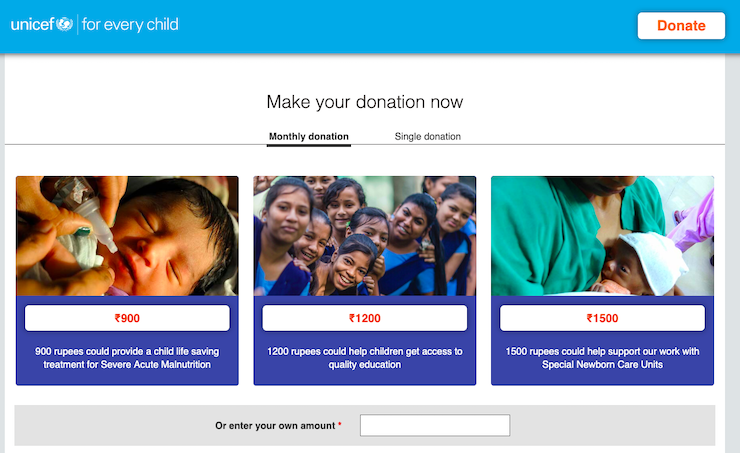
Why is this such a good page?
- They tell a story – the Real story of how they made a difference
- They make an emotional connect with the audience
- They make the audience believe their contribution is important
- They make the ask only after building a relationship
- They give various options to the prospect to make giving easier
- They have used real images to make more impact.
See if you can incorporate these elements to your site too.
Despite the difference in approach, the fundamental principle of solicitation here is still the same – win trust.
That would mean humanizing your cause, providing a great user experience online and giving your prospects a means to reach you, if they want to.
4. Crowdfunding
Under the umbrella of online donations, come crowd fundraising. Essentially, you appeal to the online masses on a platform, stating your cause. And those prospects who are interested will contribute towards it.
Though crowdfunding works well primarily for individual causes, it can work for nonprofits as well. All you have to do is add your online donation page on a site like GoFundme, and the viewers take care of the rest.
The problem however with crowdfunding is that it is highly unpredictable. If your cause does not resonate with the audience, they will not fund it.
It also has a time constraint. That is, you cannot have year-round crowdfunding campaigns. Your campaigns can extend for say 3 months or so, with a particular goal in mind.
5. Social media
Strictly speaking, social media fundraising is a form of online donation. You reach out to your followers on social media page (on Facebook, Instagram, Twitter, etc.) and encourage them to contribute to your cause.
Each of these online platforms affords an opportunity for visual storytelling. The nonprofit Charity: water is an excellent example of how to use social media for fundraising.

The biggest advantage with social media is that you can build supporters and followers virtually from anywhere across the globe (not limited by zip code).
However, it is true that it takes a lot of time. Even before you launch, you have to have a strategy in place, identify how to build followers, and engage them. It needs a lot of manpower and technical know-how to accomplish.
6. Event donations
Events are the go-to method of fundraising for all nonprofits. Auctions, galas, bake-sales, there is one for every nonprofit.
Every event needs a lot of planning and immense coordination to execute. On one end, you have to follow up with your donors and prospects to participate. On the other hand, you also have to deal with volunteer coordination.
Also, if it is a ticketed event, the ticket prices have to be planned so that it more than covers the costs for the event. This means you have two scenarios. If it is a low-cost ticket, then you have to have a lot of guests coming in. If the price is high, then you have to ensure that you sell enough tickets for the donors to join.
As a bonus, you can also run text-to-give campaigns and pledges during your event. Here are 52 event ideas that can help you plan the next fundraiser.
7. Text donations
Text messaging is a great way to fundraise for your cause. You can either send out a broadcast SMS to all your followers, with the donation link to your website. Or, you can engage each of your prospects with personalized SMS to encourage them to contribute. The latter is called peer to peer texting.
The advantage in peer to peer texting is that each reply can be customized based on the prospect’s response.
This level of personalization makes peer to peer texting conversational and not just a point-blank ask, thus increasing the chances of winning donation.
Despite the level of customization involved, peer to peer texting does not take time. A volunteer can send up to 1500 texts per hour – if he can just edit and use saved message templates.
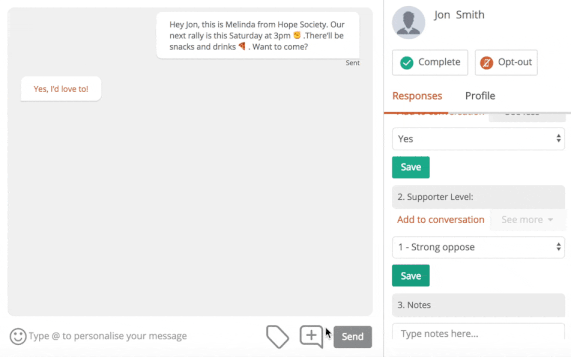
However, if you are not already using SMS to engage with your followers, then launching SMS fundraising can have overhead costs. You have to invest in software, train your volunteers and also spend money for each SMS you send out. So unless you have built a supporter base who are open to talking to you over SMS, SMS fundraising has to wait.
Watch now > Fundraising with SMS – Webinar(Opens in a new browser tab)
8. Peer to peer fundraising
Peer to peer fundraising is when each volunteer personally takes up fundraising for your cause and reaches into their personal network to solicit donations.
That means each of your volunteers have their own fundraising strategy or campaign. They target their friends, family, acquaintances and ask them to support a cause the fundraiser personally cares about. Since they already have a relationship with these prospects, the trust factor is higher and so drastically increases their chances of winning donations.
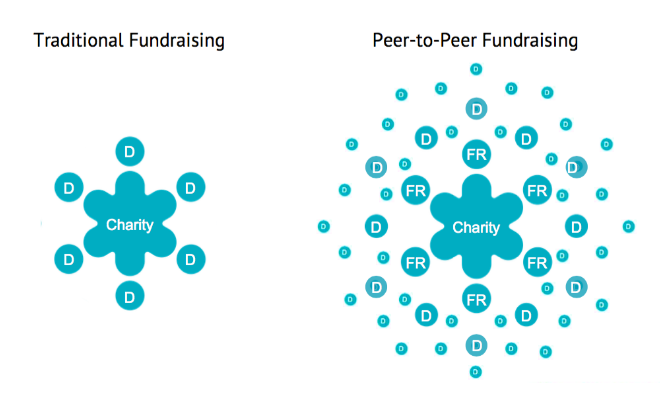
An enormous advantage to this method is that you are exponentially increasing your prospect base. Instead of one volunteer reaching out to prospects from the list you have built, multiple volunteers reach out to people in their own network. They can use SMS or a crowdfunding campaign to encourage prospects to donate.
What it would mean for you is to manage a group of peer to peer fundraisers – rather similar to volunteer management, but with a lot more motivation and appreciation.
Peer to peer fundraisers are those volunteers who are passionate about your cause, take initiative, and are willing to go the extra mile to contribute. The success of your campaign hinges on identifying such volunteers and their ability to tap into their personal connections for your network.
Read more on this:
9. Phone-a-thon
A phone-a-thon is when a group of volunteers meet at a particular time to just make calls to your donors and solicit funds for your cause. So every donor or prospect from your list can be reached out, engaged in a one-to-one conversation, and then asked for a donation.
For prospects who are otherwise typically approached via say texts or emails, this would be a refreshingly personal touch. They can relate to your organization a bit more, humanize it, and so would be a lot more willing to donate for your cause.
Phone-a-thons however, are not easy to organize. They require a lot of pre-planning and preparation.
Not only do you need to have up-to-date phone numbers of your donors, but you also need to have a set of volunteers who are willing to make the phone calls.
The first step would be reaching out to your volunteers and informing them about volunteer opportunities, including attending the event. If they agree, you have to provide them with a script and train them before they can approach a prospect.
Remember that your volunteers have to be well trained – for all intents and purposes they represent your organization. One misstep over the phone would crumble the relationship you have built with your donors thus far.
10. Pledge fundraising
The idea behind pledge fundraising is quite simple. Your supporters (or prospects), pledge to donate a certain sum. The pledge is typically collected at a later date and is always in response to a challenge or an event.
For instance, if you are a nonprofit who is focussed on helping the environment, you could ask your supporters to pledge (say a dollar) for every mile they run. Depending upon your cause and of course, the amount you want to raise, you can set your own guidelines for the event.
Though it seems simplistic, running a pledge fundraising campaign is not easy. You always need to have a set goal for the amount of money to raise.
Organizations usually use a pledge fundraising software to plan, track, and keep in touch with the pledgers.
This could substantially add to your overhead costs.
11. Recurring donations
When donors agree to contribute periodically for your cause – maybe monthly or quarterly, it falls under recurring donations. For your nonprofit, it means an assured means of regular funds. This steady source can play a huge role in planning your monthly activities.
“An average recurring donor gives 42% more than a regular one-time donor” – Network for good.
How can you go about getting more recurring donors? There are two ways to do so,
- You can give the option of monthly donation when a donor makes the first donation
- You can approach first time donors with a second ask
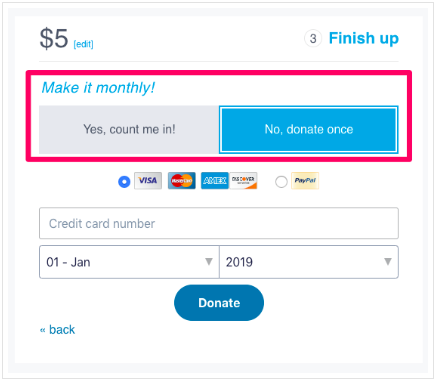
Example of encouraging monthly donation via online forms. You can either show it to every prospect or only to returning prospects.
The success of your effort lies in identifying a potential recurring donor and cultivating him right.
A recurring donor is very different from your regular donor. He contributes to your organization, not for tax reasons, but because he genuinely cares about the cause.His contributions may not be large, but still substantial enough to make a difference (it could also be via cash or kind).
You cannot approach a prospect for recurring donations right off the bat. He has to have contributed before and shown genuine enthusiasm before you can broach the subject of periodic giving.
Also, from an organizational standpoint, you have to make the transition from one-time gifts to recurring gifts as easy as possible for your donors.
That means, automating the giving process, guiding them to make donations via texts or your online form or simply offering various schedules to make the gifts.
So make recurring donation a part of your fundraising strategy – but know that it can actually take a little more time to pull off.
12. Annual campaign donations
Thus far, we have discussed donations from the perspective of contributing to a specific campaign in your cause. However, these are not what pays your organization’s bills. Your everyday organization cost of overheads, paying salaries, doing donor cultivation, etc. is based on annual campaign donations.
For instance, let us suppose that you are an organization looking to provide clean water in a specific region. To do so, you realize that installing taps at a common area, and sourcing clean water is a must. So while you could run a separate fundraising campaign for that, the entirety of your project – planning, execution, etc. is run from funds sent to the annual campaign donations.
Donors who make annual campaign donations are those who already know about your organization, have built trust, and want to make a difference to your cause.
Think of it this way. They are passionate about the cause, want to find a solution for it, and trust you to see it through. They donate via cheques or online donation forms (typically huge sums) to your cause – either year-round or at particular times during the year.
Unfortunately getting loyal donors who steadfastly donate to your annual campaigns are tough. It takes a lot of good prospecting and intense donor cultivation to win such donors.
So, if you are just starting out with fundraising efforts for your cause, this could be a long term goal you can work on.
13. Planned gifts
Ever had money bequeathed to you from a rich uncle? Yeah, me neither. But hey, the good news is that your nonprofit can.
Planned gifts are those that are set aside for your nonprofit today (with you being fully aware of it) so that you can collect it at a later date. The most common method of receiving planned gifts is as gifts or bequests in the will. The donors will, of course, get a tax rebate. For your organization, it is money that you can plan for to be used in the future.
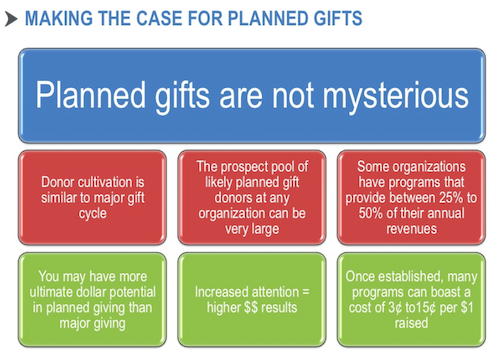
However, you cannot approach all donors requesting they add you to their will. For one, it is an extremely delicate topic (nobody wants to talk about ‘death,’ especially theirs) and two, it is an extremely big Ask.
What you can do from your end first, is to launch a planned gifting program that is ideal for you (and your donors). Ensure that it checks all the legal and technical aspects. If your team does not have the legal skill set for it, consider forming an advisory committee who can guide you right.
The next part is, of course, talking to the donors. Here is how you can do it right. Remember to target the right donors (usually, it is annual donors or those who give major gifts that are best suited for this Ask), and always tread carefully.
Unlike a lot of your individual solicitation, planned giving is more of an ongoing effort. There is no set time limit or constraint (like say for a crowdfunding project that has to raise $3000 in 30 days).
Despite the lack of pressure, this is an ask that is better suited for established nonprofits (as they are better trusted and also have a plan in place for the money).
14. Major gifts
Do you know the 80/20 rule? It says that 80% of impact typically comes from 20% causation. Well, for nonprofits, there is something rather similar when it comes to raising money.
Studies have shown that 88% of gifts come from just 12%of donations. This 12% is what is considered major gifts.
Now, how much money should it be for it to be considered a major gift entirely depends upon your nonprofit. It could be $1000 or $10,000 or even more. However, you should have a clear idea of this number before approaching a donor for such a gift.
As with any of the above gifts, asking the right donor at the right stage is crucial for major gifts. That means the donor you ask should have the means to make the donation. Also, he should already have a relationship with your organization so that he is more amenable to saying yes.
An important aspect of major gift solicitation is follow-through. That means after a donor has contributed substantially for your cause, stewardship kicks in. It could be additional perks, forming a major donor club or using the donor’s name for a specific campaign.
Having such an intensive major gift program can be a huge strain on your resources. So, ensure that your nonprofit is capable of handling that load before launching it.
15. Capital campaigns
Capital campaigns are the exact opposite of annual campaigns. It is money raised specifically for a large project, that is outside of your everyday campaign needs. It can last for even above a year (depending upon the scale of your project) and would probably take even longer to implement. In essence, think of it as a major donation towards a specific program.
Even well-established nonprofits having a massive and loyal supporter base do not launch capital campaigns at the drop of a hat.
It has to be well researched, understood how well it would be received by the prospects and the benefitting community, and launched only if the organization can have a solid impact from it.
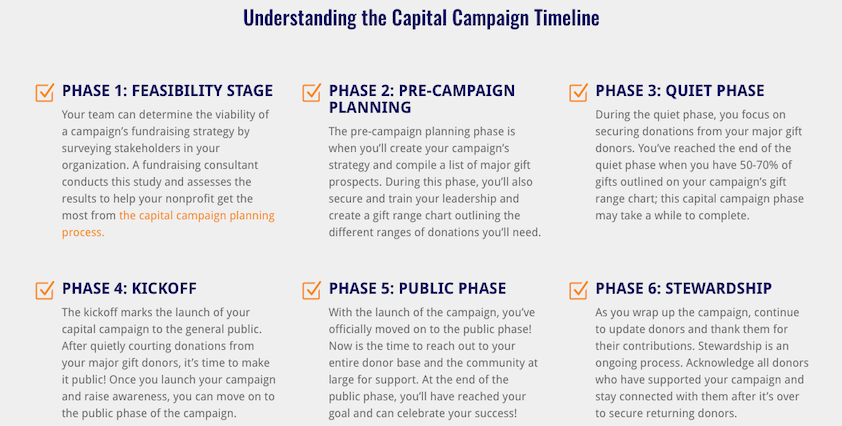
Also, once a capital campaign is approved, a lot of the solicitation is done in stealth mode. Only after 80% of the goal is reached, is the donation made open to the public. This is to ensure that a lot of major donors are not deterred by the opinion of public prospects when it comes to making asks.
As you can clearly see, a capital campaign is a lot of effort. Not only does it need immense pre-planning, but it also needs a lot of nuanced asking that comes with highly skilled volunteers. Assess the resources you have at your disposal carefully before thinking of capital campaigns.
If you do it wrong, the immediate result is a drop in fundraising. However, a crucial more long term impact would be the loss of trust you have built with your donors. Recovering from this would be much harder.
16. Door to door solicitation
Girl scout cookies. That is the first thought that pops into my head when I think of door to door solicitation. Despite the excellent recall, I can honestly tell you that I have not bought a lot of it.
And therein lies the disadvantage of door to door solicitation – it’s tough to convince a prospect to donate.

You can send out scores of volunteers (assuming you can spare them) to knock on doors. But you cannot guarantee that they will win donations from every door they knock on.
Prospects who are not convinced would say a straight out no. Prospects who have built a rapport with the volunteer but don’t fully trust your organization will part with a meager sum. Worse, prospects who have donated before and are approached again (abruptly, without any stewardship), would only feel slighted and not respond.
So, not only do you have to spend an enormous amount of volunteer man hours knocking on doors. But you also have to do your homework on the prospects so that you can encourage them to support your cause.
Remember, knocking on doors and, ‘asking for 2 minutes of prospect’s time’ could very well be construed as an interruption and annoy them. Ensure that your volunteers are aware of this possibility and approach the prospects accordingly (otherwise, your organization will just leave a bad first impression).
Related Reading: Writing the Perfect Nonprofit Fundraising Plan – In 10 Easy Steps.
Fundraising from companies
TripAdvisor gives 2% of its profits towards charity every year.
The Amazon Smile program gives back to society in it’s own way. And these are just two big names on a growing list.
In 2017 corporate giving increased by 8% (a solid $20.77 billion), showing that more and more companies are open to helping communities in need.
For your nonprofit, that is a huge opportunity. It means you can directly approach such companies to solicit funds. Before you do, research the company policy well enough and see if your organization would be a good fit.
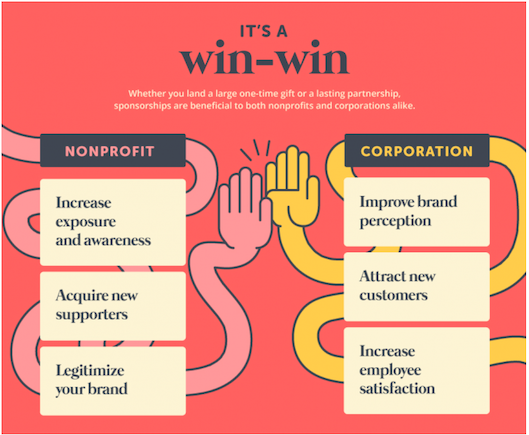
Have a clear idea of what you can ask from them to actually help you. It need not always be cash. For instance, Salesforce donates technology to nonprofits. If such gifts (in-kind) helps, then you can definitely ask them for it.
Methods to solicit funds from companies
1. Matching gifts
Essentially, the company matches a donor’s gift (to the same nonprofit) in a ratio of 1:1 or 2:1 – depending upon their policy.
For your organization, it is double the donation. For the company, it is a simple way to meet it’s Corporate Social Responsibility (CSR), and for the donor, it makes it easy to raise more money for a cause he cares about. So hey, everybody wins!
Once you identify companies (e.g. General Electric, Coco-cola) that have good matched giving programs, target prospects within the organization.
After donation, it is the donor who files the necessary paperwork with his company to see if he can boost his donation with a matched giving program.
For instance, when floods ravaged Kerala (a beautiful State in southern India), matched giving played a major role in fundraising efforts.
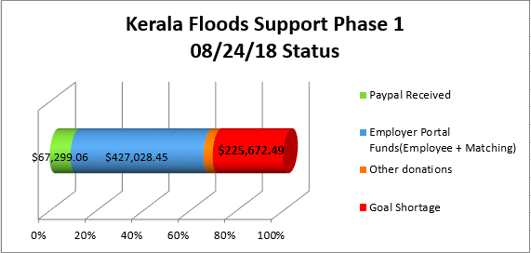
To make the process simpler, your nonprofit can use a software (like Benevity), to keep track of the whole cycle.
The company will of course read through the paperwork before deciding if the amount donated and your organization qualify for matched giving programs. If the amount given by the donor is too high or less, they wouldn’t be interested.
Similarly, if your organization does not come under the umbrella of causes they support, the request for matched giving could be rejected.
Both of these can easily be avoided by thorough research on your part. Also, cultivating a personal relationship with the prospects or someone in the company will drastically increase your chances of being approved for the program.
Otherwise, you can simply create awareness among your donors about corporate matched giving and encourage them to check with their companies about it.
2. Corporate grants
If you are a nonprofit, you must have heard of Google Ad Grants – Google’s way of helping nonprofits with ‘free’ Ads (up to $10,000) a year. When used effectively, this funding can go a long way in getting new prospects and increasing new donor acquisition.
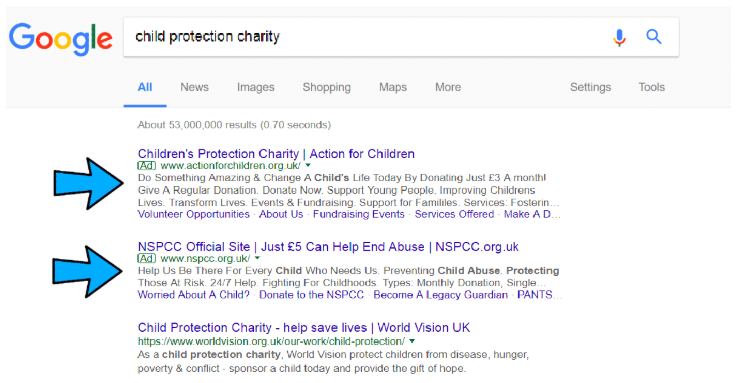
Every year, big corporates earmark a certain sum of money to give back to society via grants. Some companies like Google solicit grant applications to disburse the funds. Others like GE, do not encourage grant applications but pick nonprofits of their own choosing.
If grant application is a regular part of your annual fundraising process, you stand a good chance of winning funds from companies who have the former approach.
When companies do not actively solicit grants, you can still approach them – not to solicit funds, but to build a relationship. If the companies’ mission on CSR matches your vision, you can write to their manager for an audience.
In the first meeting, do not make an ask, but focus on getting to know their policies better.
For instance how they pick their nonprofits, what kind of help do they provide, etc. In subsequent meetings, you can talk about what your organization has achieved and finally make a case for how much difference you can make together.
There is no magic bullet to winning grants – it needs dedicated time and effort for it to succeed. If your organization does not have such resources, it would be wise to wait a bit before venturing into this.
3. Volunteer grants
Very similar to matched gifts. Instead of matching their employee’s donation, corporates match the amount of time an employee spends in volunteering for a nonprofit. Depending upon the company policy, they could match donations for volunteer work done individually, or done as a team.
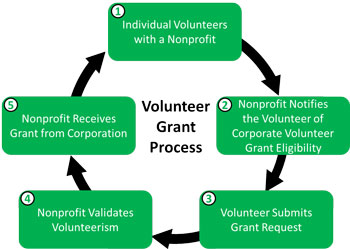
As with matched giving, it is entirely dependant on your volunteer to go file the necessary paperwork with his company to realize the volunteer grant.
That means, as a nonprofit, there is precious little you can do. Yes, you can encourage, remind , and help the volunteer to file the paperwork.
But since you have no transparency and zero involvement in the cycle, you will have no idea of knowing whether the grant will come to fruition.
This undependability in volunteer grants can be streamlined with time. Say, you frequently have volunteers from the same corporation helping you out. With time, you will not only understand how their system works but also form a personal connection – both of which will increase your chances of winning volunteer grants.
Till such time, all you can do is create awareness about volunteer grants among your prospects and supporters and periodically remind and encourage them to complete the paperwork.
4. In-kind donations
Salesforce’s policy of giving technology to nonprofits is a classic example of in-kind donations given by corporates. Yes, money goes a long way – but it is not everything.
Since your organization has its own means of raising funds, corporates ‘play to their strengths’ to help you in the best way they can.
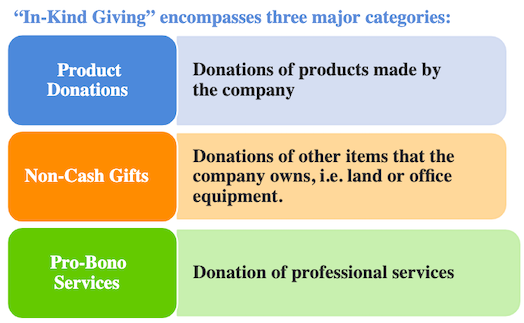
Typically, such in-kind donations are offered by corporations whom you have built a relationship with. For instance, they could offer to sponsor food or drinks for your next event. Or (if it is possible), help you by loaning materials to complete a project.
While this kind of beneficial relationship would take some time for you to build, getting these donations would mean that you complete your projects on time or hold events well.
Keep in mind that in kind donations are not always spontaneous. Sometimes, you will have to make the ask – solicit for items exactly how you would ask for funds. Rather like a fundraising ask, that means doing your research, asking the right item from the right company, and providing compelling reasons for the donation.
To help you with that, here is a quick stats on In-kind giving by industry. As expected, Health Care Industry tops the rest.
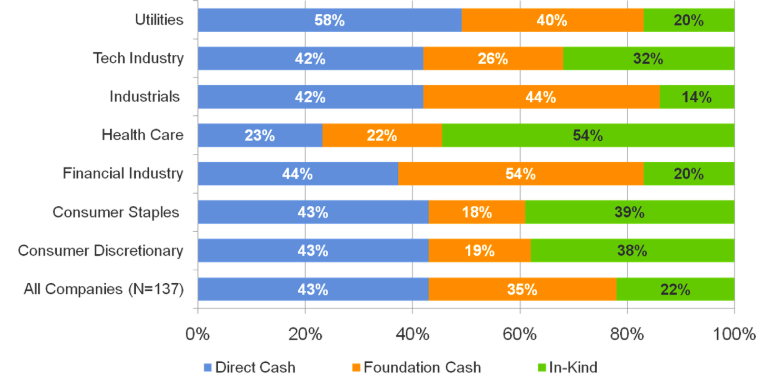
However, since asking for a donation in-kind is a low barrier ask (as opposed to asking for money), the chances of your getting a yes is higher.
5. Discretionary gifts
Discretionary gifts are those that are sanctioned independently by an authority within the corporate. For instance, the manager of the grant foundation could make you a monetary donation, based on his discretion, if in case your grant application has been rejected.
However, the manager cannot give you the gift willy nilly. Your nonprofit should first be eligible for receiving that money.
Secondly, it should be proven beyond doubt that you have immensely helped the society and thirdly, you should be able to make a pretty good case of how the money would help.
Even though having a relationship with the corporate would make this easier, discretionary gifts are few and rare to come by.
Opting for a discretionary gift is more a ‘contingency plan’ rather than purposely setting out to claim it.
6. Sponsorship
Very similar to in-kind donations, sponsorships are when a corporate decides to sponsor a part of your nonprofit effort.
It could be as simple as taking care of food at an event to something at a much larger scale – like monetary sponsorship of your nonprofit’s effort in an entire region.
However, it is important to choose the right kind of corporate to sponsor your organisation. The American Academy of Family Physicians was criticized in 2010 for partnering with coca-cola. So, ensure that your nonprofits mission aligns with the interests of your sponsors.
Corporate sponsorships can tarnish the image of a nonprofit organization
Typically, sponsorships are not long-term commitments. Neither are the companies bound to repeat the same sponsorship year after year.
This could work in your favor because then sponsorship becomes a low-barrier ask. You stand a much better chance of getting a positive response from your target.
Also, it is an excellent opportunity to get to know your corporate partner, win their trust, and build a relationship with them.
Remember that not all corporates offer every giving program listed above. For instance, Google has a written policy on grants, volunteer grants, and matched giving program. GE is primarily known for its grant policy and so on.
So it is up to you to decide which company to target and identify which fundraising program would work for you. Take the help of your board members and your advisory committee to strategize if needed.
Fundraising from grants
Essentially, grants are sums of money set aside by any organization (private or public) for a particular purpose. The key phrase here is ‘particular purpose.’ It means that the organization cannot hand over the donation to just anyone- they can only do it to those nonprofits which align with their mission.
Remember, writing grant proposals are tedious and thankless. So use this channel of fundraising only if you have enough manpower and resources to handle it.

There are two kinds of grants:
Community Foundation Grants:
Grants that are funded by private corporations or the State. These are actually non-profits whose sole role is to disburse money to other organizations who use it for their cause.
Private Foundation Grants:
Funded by private individuals or families, these grants usually have a board that makes the decision as to which nonprofit receives the grant sum.
Here is a complete list of the grants which you can check to see if anything can help your organization. Apply only to grants that you are eligible for. Even though grant application is a tedious and time-consuming process, it would definitely be worth it to get a steady source of funds annually.
And then, don’t forget to follow-through
So, once you pick a fundraising strategy (or few), that work for you, go ahead and get your volunteers on to execute it. But remember, a lot of these fundraising strategies work because of excellent donor stewardship after the ask!
The aim of your stewardship is threefold: to get your donors to keep giving, to get your donors to give more (upgrade) and finally to get your donors to refer new donors. Be it an individual, a corporate, or a foundation, it is crucial to keep your donors happy. That could mean anything from regular updates to inviting them to events or having exclusive donor clubs with perks.
Which is why no fundraising strategy is complete without a stewardship plan. If you are stuck for ideas, this article on donor retention can help you further.
What to next? Do some fresh reading
- How A Major Nonprofit Turned Tens of Thousands of Daily Calls Into an Actionable Strategy with AI
- 275000 Calls With CallHub: How To Plan A Victorious Campaign
- A Call Can Empower Millions! Changing Lives with CallHub
- How a Nonprofit Organized 500+ Callers to Mobilize 1M+ Voters
- NY Cares & CallHub’s ‘Mission Vet Check’: A Lifeline for Veterans

